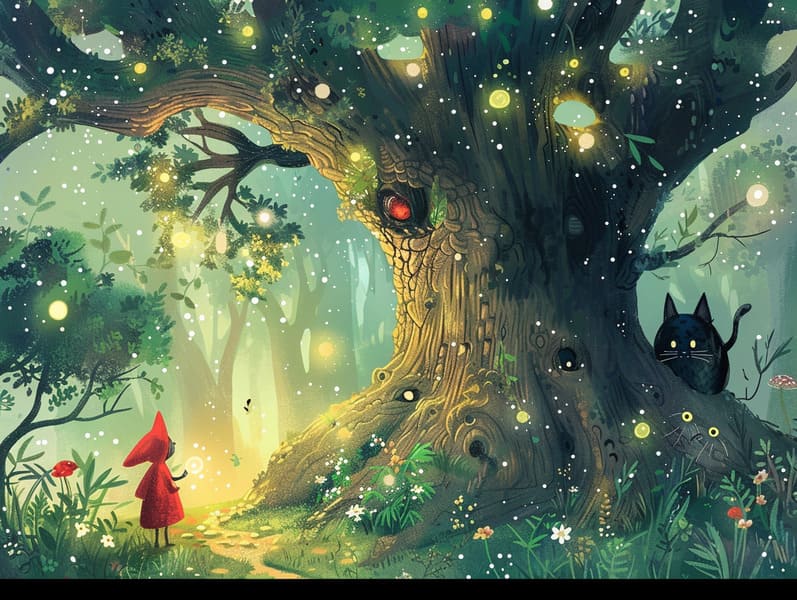
Old fairy tales have old origins. These tales have been transmitted from one generation to the next millennia before they were ever documented. They arose from a variety of backgrounds, including Middle Eastern traditions. They were initially conveyed among grown-ups, often carrying themes and messages relevant to the societal norms and beliefs of the time.
The Grimm brothers, Jacob and Wilhelm Grimm, were among the first to gather and publish many of these beloved narratives. Their collection, "Grimm's Children's Stories," included tales like "Ashenputtel," "Hansel and Grethel," and "Snow White," which have since become mainstays in the world of iconic fairy tales. Similarly, Andersen's magical narratives, such as "The Little Mermaid," and "The Ugly Duckling," have won hearts worldwide, solidifying their place in the pantheon of timeless fairy tales.
Though they are centuries old, classic fairy tales remain as relevant as ever, especially as nighttime stories for kids. These whimsical stories are now available in numerous formats, including richly illustrated books, captivating animations, and digital fairy tales.
Their lasting presence can be linked to several charming aspects:
Key Lessons: Traditional fairy tales often share important moral lessons. Narratives like "The Boy Who Cried Wolf" teach the virtue of truthfulness, while "The Hare and the Tortoise" emphasize the values of tenacity and humbleness. These stories offer the young clear distinctions between good and bad, guiding their moral compass in a subtle yet meaningful way.
Warmth and Understanding: Fairy tales frequently involve characters facing obstacles and hardships, urging listeners to identify with their struggles and support their triumphs. For instance, "Beauty and Her Beast" teaches us the significance of valuing inner qualities to understand the real character of a person, advancing perception and awareness.
Cultural Awareness: Many timeless fairy tales are steeped in the cultural contexts from which they came. Engaging with these tales can provide illuminating insights into different societies, cultivating a sense of world respect and acknowledgment.
Creativity and Fantasy: The magical elements in traditional fairy tales—enchanted forests—spark children’s dreaming abilities. These fairy tales take readers to magical realms, provoking imaginative ideas and a sense of curiosity that endures a lifetime.
Traditional fairy tales are not only captivating but also pedagogical. They act as mesmerizing tools in developing various cognitive and affective skills in kids. When ancient fairy tales are narrated, they cultivate language skills by showing new terms and meanings and complex sentence structures. This practice also nurtures listening skills and attentiveness, as young readers remain attentive, expectant to see what happens next.
Furthermore, conversing about the themes and characters of fairy tales can improve problem-solving abilities and logical thinking. Young ones are shown to notice patterns, predict happenings, and understand cause and effect. These reflections also advance young ones express their thoughts and feelings, boosting their emotional intelligence.
In today’s digital era, the existence of web-based fairy tales has made these tales more accessible than ever. Web platforms and software give vast collections of Grimm's fairy tales that can be looked at or listened to anytime, anywhere. Fairy tales narrated are particularly liked, extending an immersive method for little ones to delight in these fantastical tales. Audio stories and read-to-me videos move characters and settings to life, often supplemented by mesmerizing sound effects and soundtracks that raise the narrative experience.
The unfading fascination of timeless fairy tales lies in their ability to shift to modern days while holding onto their main lessons. Contemporary adaptations of these tales often highlight more different figures and modern settings, making them pertinent to today’s audience. However, the essential messages of fortitude, compassion, and integrity remain unchanged, continuing to reach kids of all ages.
Fairy tales also offer a sense of ease and recognition. They deliver a coherent narrative with a apparent beginning, middle, and end, often coming to a close with the termination of conflicts and the triumph of rightness over wrongness. This foreseeability can be placating for little ones, yielding a sense of sturdiness in an fluid world.
Old fairy tales continue to spellbind and train new generations, maintaining their attraction and meaningfulness in modern society. As kids' bedtime tales, they make available a perfect blend of delight and instruction, supporting moral values, empathy, click here and creativity. The presence of digital storybooks and the popularity of fairy tales read aloud secure that these traditional narratives remain available to new generations.
By conserving and narrating these fairy tales, we continue to treasure the rich tapestry of human imagination and cultural heritage. Whether you are accessing a richly illustrated book, enjoying a electronic collection, or listening on an spoken story, the magic of ancient fairy tales is always within reach. These tales remind us of the undying magic of narratives and its ability to unite us across eras and regions.
Even if you are reading a vividly illustrated book, delving into a virtual collection, or listening to an narrated book, the attraction of old fairy tales is always within reach.
These stories convey of the unceasing strength of fairy tales and its ability to unify us across epochs and places, establishing a link that fascinates and enlightens alike.